 Malcolm Lowry. Toronto: McClelland and Stewart, 1971. A brief introduction to the life and writings of Malcolm Lowry, including a survey of the works that in 1970 were accessible only in manuscript form.
Malcolm Lowry. Toronto: McClelland and Stewart, 1971. A brief introduction to the life and writings of Malcolm Lowry, including a survey of the works that in 1970 were accessible only in manuscript form.
 Articulating West: Essays on Purpose and Form in Modern Canadian Literature. Toronto: New Press, 1972. One of the earliest critical books to break from the nationalist model of literary criticism in order to examine the function of writers’ formal choices, in particular their resistance to received models and their desire for a more flexible language for the myths of an indeterminate and metaphorical ‘wilderness.’ Contents include discussions of Pratt, Ross, Wilson, MacLennan, Kroetsch, Laurence, Avison, Birney, and others.
Articulating West: Essays on Purpose and Form in Modern Canadian Literature. Toronto: New Press, 1972. One of the earliest critical books to break from the nationalist model of literary criticism in order to examine the function of writers’ formal choices, in particular their resistance to received models and their desire for a more flexible language for the myths of an indeterminate and metaphorical ‘wilderness.’ Contents include discussions of Pratt, Ross, Wilson, MacLennan, Kroetsch, Laurence, Avison, Birney, and others.
 Dramatists in Canada: Selected Essays (ed.). Vancouver: U of British Columbia Press, 1972. A selection of essays on theatre and drama from the quarterly journal Canadian Literature, together with new essays on James Reaney, John Herbert, Simon Gray, and Quebec drama, written especially for this volume.
Dramatists in Canada: Selected Essays (ed.). Vancouver: U of British Columbia Press, 1972. A selection of essays on theatre and drama from the quarterly journal Canadian Literature, together with new essays on James Reaney, John Herbert, Simon Gray, and Quebec drama, written especially for this volume.
 Among Worlds: An Introduction to Modern Commonwealth and South African Fiction. Erin, ON.: Press Porcépic,1975. Introductory survey essays on the fiction of the West Indies, South Africa (not a member state of the Commonwealth in 1975), East & West Africa, Canada, New Zealand, Australia, and South Asia. Irony is a recurrent motif, as the essays examine the strategies writers devised in order to resist the colonial past and adapt the English language to their own purposes. The plurality alluded to in the title, while suggesting the recurrent patterns that characterize the writing in the various societies, also insists on the divergences that place and politics have provoked.
Among Worlds: An Introduction to Modern Commonwealth and South African Fiction. Erin, ON.: Press Porcépic,1975. Introductory survey essays on the fiction of the West Indies, South Africa (not a member state of the Commonwealth in 1975), East & West Africa, Canada, New Zealand, Australia, and South Asia. Irony is a recurrent motif, as the essays examine the strategies writers devised in order to resist the colonial past and adapt the English language to their own purposes. The plurality alluded to in the title, while suggesting the recurrent patterns that characterize the writing in the various societies, also insists on the divergences that place and politics have provoked.
 Margaret Laurence: The Writer and Her Critics (ed.). Toronto: McGraw‑Hill, 1977. A sampling of Laurence criticism, to the date of publication.
Margaret Laurence: The Writer and Her Critics (ed.). Toronto: McGraw‑Hill, 1977. A sampling of Laurence criticism, to the date of publication.
 A Political Art: Essays and Images in Honour of George Woodcock (ed.) . Vancouver: U of British Columbia Press, 1978. A collection of new essays (by Margaret Laurence, Arthur Erickson, Ramsay Cook, Julian Symons, Mulk Raj Anand, and others), together with poems (by Denise Levertov, Tom Wayman, Kathleen Raine, Al Purdy, Roy Fuller, and others) and visual art (by Jack Shadbolt, P.K. Irwin, Bob Steele, Jack Wise, Gordon Smith, Alistair Bell, and others), all prepared in honour of George Woodcock.
A Political Art: Essays and Images in Honour of George Woodcock (ed.) . Vancouver: U of British Columbia Press, 1978. A collection of new essays (by Margaret Laurence, Arthur Erickson, Ramsay Cook, Julian Symons, Mulk Raj Anand, and others), together with poems (by Denise Levertov, Tom Wayman, Kathleen Raine, Al Purdy, Roy Fuller, and others) and visual art (by Jack Shadbolt, P.K. Irwin, Bob Steele, Jack Wise, Gordon Smith, Alistair Bell, and others), all prepared in honour of George Woodcock.
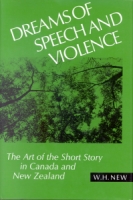 Dreams of Speech and Violence: The Art of the Short Story in Canada and New Zealand. Toronto: U of Toronto Press, 1987. The first extended history of the short story in each of the two countries, this book begins with a study of existing short story theory and of its inapplicability in Canada and New Zealand, and hence the need for alternative ways of reading. The complementary histories demonstrate two differing social contexts and the connections between society and storytelling. The book then examines the dynamics of (a) three linked story sequences (by D.C. Scott, Margaret Laurence, Alice Munro) and (b) variant forms of “speaking” (in Mansfield’s “At the Bay” and in stories by Frank Sargeson, Patricia Grace, and Maurice Duggan). An extended appendix provides a dictionary of short story terminology.
Dreams of Speech and Violence: The Art of the Short Story in Canada and New Zealand. Toronto: U of Toronto Press, 1987. The first extended history of the short story in each of the two countries, this book begins with a study of existing short story theory and of its inapplicability in Canada and New Zealand, and hence the need for alternative ways of reading. The complementary histories demonstrate two differing social contexts and the connections between society and storytelling. The book then examines the dynamics of (a) three linked story sequences (by D.C. Scott, Margaret Laurence, Alice Munro) and (b) variant forms of “speaking” (in Mansfield’s “At the Bay” and in stories by Frank Sargeson, Patricia Grace, and Maurice Duggan). An extended appendix provides a dictionary of short story terminology.
 Literary History of Canada: Canadian Writing in English (ed.). Vol 4. Toronto: U of Toronto Press, 1990. This volume extends coverage of Carl Klinck’s second edition of the LHC to cover the period 1972-1984. Sixteen chapters, each written by an expert in the field, discuss poetry, novel, theatre and drama, translation, theory and criticism, writing for the media (including film), children’s literature, folklore, life-writing, the publication industry, and writings in history and the social sciences. The volume also introduces the LHC’’s first separate chapter on short fiction.
Literary History of Canada: Canadian Writing in English (ed.). Vol 4. Toronto: U of Toronto Press, 1990. This volume extends coverage of Carl Klinck’s second edition of the LHC to cover the period 1972-1984. Sixteen chapters, each written by an expert in the field, discuss poetry, novel, theatre and drama, translation, theory and criticism, writing for the media (including film), children’s literature, folklore, life-writing, the publication industry, and writings in history and the social sciences. The volume also introduces the LHC’’s first separate chapter on short fiction.
 Native Writers and Canadian Writing (ed.). Vancouver: U of British Columbia Press, 1990. One of the first modern booklength works to consider the politics, aesthetics, and preoccupations of Inuit and First Nations writing in Canada. Contributors to the collection include Thomas King, Shirley Bear, Robert Bringhurst, Margaret Atwood, Lee Maracle, Basil H. Johnston, Rita Joe, Robin Ridington, Daniel David Moses, and Alootook Ipellie.
Native Writers and Canadian Writing (ed.). Vancouver: U of British Columbia Press, 1990. One of the first modern booklength works to consider the politics, aesthetics, and preoccupations of Inuit and First Nations writing in Canada. Contributors to the collection include Thomas King, Shirley Bear, Robert Bringhurst, Margaret Atwood, Lee Maracle, Basil H. Johnston, Rita Joe, Robin Ridington, Daniel David Moses, and Alootook Ipellie.
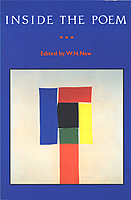 Inside the Poem (ed.). Toronto: Oxford, 1992. [Essays and Poems in honour of Donald Stephens] This anthology collects 24 familiar Canadian poems (by Atwood, Avison, Birney, Bringhurst, Klein, Kroetsch, Marlatt, Wah, Webb, and others) together with essays by major critics on each of these poems. Twenty-eight new poems by such writers as Lane, Page, Bissett, Tostevin, and Moses complete the volume.
Inside the Poem (ed.). Toronto: Oxford, 1992. [Essays and Poems in honour of Donald Stephens] This anthology collects 24 familiar Canadian poems (by Atwood, Avison, Birney, Bringhurst, Klein, Kroetsch, Marlatt, Wah, Webb, and others) together with essays by major critics on each of these poems. Twenty-eight new poems by such writers as Lane, Page, Bissett, Tostevin, and Moses complete the volume.
 A History of Canadian Literature. London: Macmillan, and New York: New Amsterdam, 1989; rpt. Montreal: McGill-Queen’s UP, 2001. 2nd edition, revised, Montreal: MQUP, 2003. Trans. by Wu Chizhe, Wang Qingxiang, and Huang Zhigang as Jia Na Da Wen Xue Shi. Beijing: People’s Literature Publishing House, 1994. Rather than deal only with “great” figures, or explicate only “aesthetically pleasing” texts, or follow an easy progressivist model, this unorthodox history of Canadian literature (i.e., literature written primarily in English and French) focuses on relations between social trends and literary preoccupations, from oral tale-telling onwards. Initially the coverage ended in the 1980s; a new chapter in the 2nd edition extended coverage to address literature written into the early 21st century. The book was called “exceptional” (E.D. Blodgett, in Five-Part Invention: A History of Literary History in Canada). A review in the Library Journal reads: “a marvelous job of detailing the taproots and multiple branches of Canada’s English and French literatures, in all their forms. Beginning with Inuit and Indian myths, New charts the development of Canadian literature…. In the process, he ties many of its themes to the history, politics, and social organization of the emerging nation. A useful chronology links literature and historical events, and a fine bibliography of primarily Canadian sources is also included…. Recommended for all academic and most public libraries.”
A History of Canadian Literature. London: Macmillan, and New York: New Amsterdam, 1989; rpt. Montreal: McGill-Queen’s UP, 2001. 2nd edition, revised, Montreal: MQUP, 2003. Trans. by Wu Chizhe, Wang Qingxiang, and Huang Zhigang as Jia Na Da Wen Xue Shi. Beijing: People’s Literature Publishing House, 1994. Rather than deal only with “great” figures, or explicate only “aesthetically pleasing” texts, or follow an easy progressivist model, this unorthodox history of Canadian literature (i.e., literature written primarily in English and French) focuses on relations between social trends and literary preoccupations, from oral tale-telling onwards. Initially the coverage ended in the 1980s; a new chapter in the 2nd edition extended coverage to address literature written into the early 21st century. The book was called “exceptional” (E.D. Blodgett, in Five-Part Invention: A History of Literary History in Canada). A review in the Library Journal reads: “a marvelous job of detailing the taproots and multiple branches of Canada’s English and French literatures, in all their forms. Beginning with Inuit and Indian myths, New charts the development of Canadian literature…. In the process, he ties many of its themes to the history, politics, and social organization of the emerging nation. A useful chronology links literature and historical events, and a fine bibliography of primarily Canadian sources is also included…. Recommended for all academic and most public libraries.”
 Land Sliding: Imagining Space, Presence & Power in Canadian Writing. Toronto: U of Toronto Press, 1997. From the book: “I do not assume that the land is a ‘natural’ image for a distinctive national character, or that a national character is by definition fixed. Instead of accepting the land as a concluding image of identity, in consequence, I am interested in why it has so often been accepted as though it were, and what this acceptance implies.” Illustrated in black-and-white, and constructed as a spatial dialogue, the book deals with ways in which literature in Canada, when alluding to the land, makes differing assumptions about value and constructs shifting definitions of nature, garden, “natural” wilderness, property, region, space and site.
Land Sliding: Imagining Space, Presence & Power in Canadian Writing. Toronto: U of Toronto Press, 1997. From the book: “I do not assume that the land is a ‘natural’ image for a distinctive national character, or that a national character is by definition fixed. Instead of accepting the land as a concluding image of identity, in consequence, I am interested in why it has so often been accepted as though it were, and what this acceptance implies.” Illustrated in black-and-white, and constructed as a spatial dialogue, the book deals with ways in which literature in Canada, when alluding to the land, makes differing assumptions about value and constructs shifting definitions of nature, garden, “natural” wilderness, property, region, space and site.
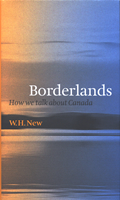 Borderlands: How We Talk About Canada. Vancouver: UBC Press, 1998. Trans. by Wu Chizhe, Xu Kun, et al. as Jiaocha Didai: Women zheyang biyu Jia’nada, with a new Introduction. Hoh-hot: Inner Mongolia University Press, 2000. The three essays collected in this book began as the Brenda and David McLean lectures in 1997. Taking the “border” as their theme, the essays discuss the “giddiness” or indeterminacy of limits—construing the border not as a line but as a resonance, a dance with alternatives. From the book jacket: “Examining how we talk about Canada, [New] shows how our territories of argument and irony shape the way we as Canadians negotiate social change, and how our often uneasy engagements with language and history make the country real.”
Borderlands: How We Talk About Canada. Vancouver: UBC Press, 1998. Trans. by Wu Chizhe, Xu Kun, et al. as Jiaocha Didai: Women zheyang biyu Jia’nada, with a new Introduction. Hoh-hot: Inner Mongolia University Press, 2000. The three essays collected in this book began as the Brenda and David McLean lectures in 1997. Taking the “border” as their theme, the essays discuss the “giddiness” or indeterminacy of limits—construing the border not as a line but as a resonance, a dance with alternatives. From the book jacket: “Examining how we talk about Canada, [New] shows how our territories of argument and irony shape the way we as Canadians negotiate social change, and how our often uneasy engagements with language and history make the country real.”
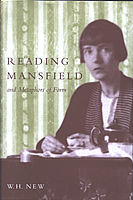 Reading Mansfield and Metaphors of Form. Montreal: McGill-Queens UP, 1999. Shortlisted for the Klibansky Prize. This study examines Katherine Mansfield’s strategies of composition, emphasizing the importance of rhetorical decisions to the substance and effect of her stories. A study of her manuscript practice (word choice, revisions) leads to “a catalogue of forms” and to an argument about how form functions as a metaphoric equivalence to a way of seeing the world. The study concludes with close readings of particular stories (e.g., “Prelude,” “Je ne parle pas français,” “The Escape”) as examples of formal reiteration, formal deferral, epilogue, prelude, and formal reconstruction. The critic Roger Robinson calls the book “The best critical book on Mansfield…wholly original and immensely valuable…, energetic, lucid, persuasive, direct.”
Reading Mansfield and Metaphors of Form. Montreal: McGill-Queens UP, 1999. Shortlisted for the Klibansky Prize. This study examines Katherine Mansfield’s strategies of composition, emphasizing the importance of rhetorical decisions to the substance and effect of her stories. A study of her manuscript practice (word choice, revisions) leads to “a catalogue of forms” and to an argument about how form functions as a metaphoric equivalence to a way of seeing the world. The study concludes with close readings of particular stories (e.g., “Prelude,” “Je ne parle pas français,” “The Escape”) as examples of formal reiteration, formal deferral, epilogue, prelude, and formal reconstruction. The critic Roger Robinson calls the book “The best critical book on Mansfield…wholly original and immensely valuable…, energetic, lucid, persuasive, direct.”
 Grandchild of Empire: About Irony, Mainly in the Commonwealth. Vancouver: Ronsdale 2003. This work was first delivered as the 2002 Sedgewick Lecture at the University of British Columbia, and is printed here with a series of complementary illustrations. Drawing on a wide range of examples, the text argues that irony, in societies without conventional political power (as in colonies or satellite states, for instance), functions to destabilize existing notions of order and at the same time to articulate the social aspirations or alternatives that these societies severally claim to stand for. A further thread in the book tells a personal narrative, at once a memoir and a tribute to the author’s father. One reviewer calls this “a small gem of a book that provides much upon which to meditate and debate.”
Grandchild of Empire: About Irony, Mainly in the Commonwealth. Vancouver: Ronsdale 2003. This work was first delivered as the 2002 Sedgewick Lecture at the University of British Columbia, and is printed here with a series of complementary illustrations. Drawing on a wide range of examples, the text argues that irony, in societies without conventional political power (as in colonies or satellite states, for instance), functions to destabilize existing notions of order and at the same time to articulate the social aspirations or alternatives that these societies severally claim to stand for. A further thread in the book tells a personal narrative, at once a memoir and a tribute to the author’s father. One reviewer calls this “a small gem of a book that provides much upon which to meditate and debate.”
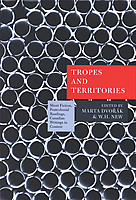 Tropes and Territories: Short Fiction, Postcolonial Readings, Canadian Writings in Context (ed. with Marta Dvořák). Montreal: McGill-Queen’s UP, 2007; introduction, pp. 3-13. This collection of essays by distinguished writers and critics, which derives mainly from a conference at the Sorbonne in 2005, demonstrates how current debates in postcolonial criticism bear on the reading, writing, and status of short fiction. One reviewer notes: “A refreshing emphasis on close reading and attentiveness to language, tone, imagery, metaphor, and metonymy make this a most welcome collection.” Subjects include Mansfield, Frame, Munro, Rushdie, MacLeod, Gallant, Narayan, Jarman, King, Métis narratives, and Maori myth.
Tropes and Territories: Short Fiction, Postcolonial Readings, Canadian Writings in Context (ed. with Marta Dvořák). Montreal: McGill-Queen’s UP, 2007; introduction, pp. 3-13. This collection of essays by distinguished writers and critics, which derives mainly from a conference at the Sorbonne in 2005, demonstrates how current debates in postcolonial criticism bear on the reading, writing, and status of short fiction. One reviewer notes: “A refreshing emphasis on close reading and attentiveness to language, tone, imagery, metaphor, and metonymy make this a most welcome collection.” Subjects include Mansfield, Frame, Munro, Rushdie, MacLeod, Gallant, Narayan, Jarman, King, Métis narratives, and Maori myth.
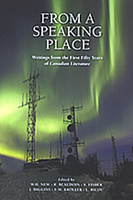 From a Speaking Place: Writings from the First Fifty Years of “Canadian Literature.” Ed., with Réjean Beaudoin, Susan Fisher, Iain Higgins, Eva-Marie Kröller, and Laurie Ricou. Vancouver: Ronsdale, 2009.
From a Speaking Place: Writings from the First Fifty Years of “Canadian Literature.” Ed., with Réjean Beaudoin, Susan Fisher, Iain Higgins, Eva-Marie Kröller, and Laurie Ricou. Vancouver: Ronsdale, 2009.